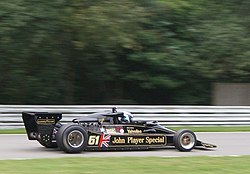Lotus 78
 |
|||||||||||
| Category | Formula One | ||||||||||
|---|---|---|---|---|---|---|---|---|---|---|---|
| Constructor | Team Lotus | ||||||||||
| Designer(s) |
Peter Wright Colin Chapman Martin Ogilvie Tony Rudd Ralph Bellamy |
||||||||||
| Predecessor | Lotus 77 | ||||||||||
| Successor | Lotus 79 | ||||||||||
| Technical specifications | |||||||||||
| Chassis | Aluminium monocoque | ||||||||||
| Suspension (front) | Double wishbone, inboard spring/damper | ||||||||||
| Suspension (rear) | Parallel top links, lower wishbones, twin radius arms, outboard spring/damper | ||||||||||
| Axle track | Front: 1,702 mm (67.0 in) Rear: 1,600 mm (63 in) |
||||||||||
| Wheelbase | 2,741 mm (107.9 in) | ||||||||||
| Engine | Ford-Cosworth DFV, 2,993 cc (182.6 cu in), V8, naturally aspirated, mid-engined, longitudinally mounted | ||||||||||
| Transmission | Hewland FG400 5-speed manual | ||||||||||
| Weight | 588 kg (1,296.3 lb) | ||||||||||
| Fuel | Valvoline | ||||||||||
| Tyres | Goodyear | ||||||||||
| Competition history | |||||||||||
| Notable entrants |
John Player Team Lotus, Rebaque |
||||||||||
| Notable drivers |
|
||||||||||
| Debut | 1977 Argentine Grand Prix | ||||||||||
|
|||||||||||
| Constructors' Championships | 1 (1978) | ||||||||||
| Drivers' Championships | 1 (Mario Andretti, 1978) | ||||||||||
The Lotus 78 'wing car' was a Formula One racing car used in the 1977 and 1978 seasons. It was designed by Peter Wright, Colin Chapman, Martin Ogilvie and Tony Rudd, and was the car that started the ground effect revolution in Formula One.
In early 1976, spurred on by the disappointing lack of pace of the ageing Lotus 72 the previous season, and the indifferent performance of the current Lotus 77, Chapman wrote a 27-page document detailing his ideas on low drag air penetration. After he had studied a de Havilland Mosquito fighter bomber, he paid close attention to its wing mounted radiators, and the hot air outlets that were designed to induce lift. Chapman realised that such a system inverted could give significant downforce. Careful examination of Bernoulli's principle of fluid dynamics confirmed his thoughts on the effects of an upturned aeroplane wing profile fitted to the car, and gave the document to his head of engineering Tony Rudd.
Rudd appointed a team to work on the project: chief designer Ralph Bellamy, vehicle engineer Martin Ogilvie and aerodynamicist Peter Wright. Rudd and Wright had previously worked for BRM, and before joining Lotus in 1970 had done a design study into the possibility of an inverted wing profile fitted to one of their cars. Rudd had tested a number of scale models, but lack of the right testing methods and BRM's declining fortunes meant development had never got beyond the experimental stage. However, Wright remembered their work and brought it into the project.
Wright then set about experimenting with F1 car body shapes using a wind tunnel and a rolling road, when by happy accident he began to get remarkable results in one of the models. Closer inspection found that as the rolling road's speed increased, the shaped underbody was being drawn closer to the surface of the road. Wright experimented with pieces of cardboard attached to the side of the model car body, and the level of perceived downforce produced was phenomenal. The results were presented to Colin Chapman, who gave the team free rein to come up with an F1 chassis design.
...
Wikipedia
